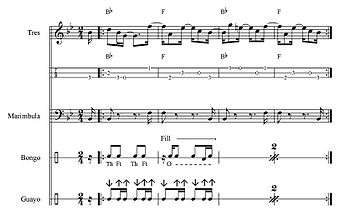Changüí
| Music of Cuba | |
|---|---|
| General topics | |
| Related articles | |
| Genres | |
| |
| Specific forms | |
| Religious music | |
| Traditional music |
|
| Media and performance | |
| Music awards | Beny Moré Award |
| Nationalistic and patriotic songs | |
| National anthem | La Bayamesa |
| Regional music | |
| |
Changüí is a style of Cuban music which originated in the early 19th century in the eastern region of Guantánamo Province, specifically Baracoa. It arose in the sugar cane refineries and in the rural communities populated by slaves. Changüí combines the structure and elements of Spain's canción and the Spanish guitar with African rhythms and percussion instruments of Bantu origin. Changüí is considered a predecessor of son montuno (the ancestor of modern salsa), which has enjoyed tremendous popularity in Cuba throughout the 20th century.
Changüí is related to the other regional genres of nengón and kiribá and is descended from nengón.[1] Technically, the changüi ensemble consists of: marímbula, bongos, tres, güiro (or guayo) and one or more singers.[2] Changüi does not use the Cuban key pattern (or guide pattern) known as clave.[3] The tres typically plays offbeat guajeos (ostinatos), while the guayo plays on the beat.


External links
- Cuban Tres - The 3 string guitar instrument from Cuba
- "Ritmo changüí" (Grupo Exploracion). Web. YouTube. https://www.youtube.com/watch?v=CvxWYQSHUYg
References
- ↑ Lapidus, Ben (2008). Origins of Cuban Music and Dance; Changüí p. 96. Lanham, MA: Scarecrow Press. ISBN 978-0-8108-6204-3
- ↑ Griffin, Jon. "Changüi - Traditional Music from Guantanamo Cuba". http://salsablanca.com/ethnomusicology/cuban-music-styles/changui-traditional-music-from-guantanamo-cuba/ July 2013. External link in
|work=(help); - ↑ Lapidus, Ben (2008) p. 140.
- ↑ Moore, Kevin (2010). Beyond Salsa Piano; The Cuban Timba Piano Revolution v.1 The Roots of Timba Tumbao p. 17. Santa Cruz, CA: Moore Music.
- ↑ Griffin, Jon (1999). Personal Collection